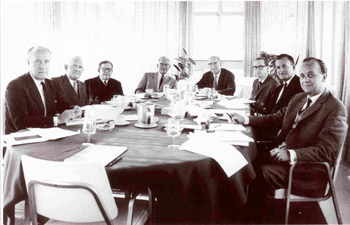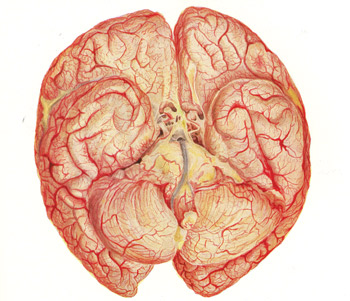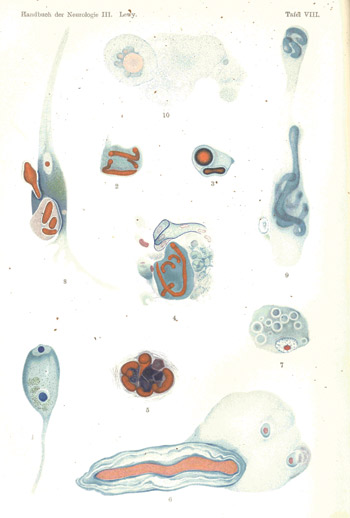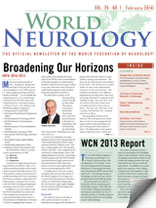
Peter J. Koehler
Peter J. Koehler, MD, PhD, FAAN
Since we started this history column in 2010, we have paid attention to international relationships in the neurosciences, in particular the exchange of students and neurologists among institutes. In this essay, I will describe another way of international cooperation that coincided with the evolution of the specialization of neurology.
In general, specialization in medicine is considered to have started in the second half of the 19th century. It was accompanied by the establishment of journals, societies, university chairs, the invention and application of new instruments (ophthalmoscope, reflex hammers, etc., for neurology), and the publication of comprehensive textbooks.

Editorial advisory board of Vinken and Bruyn in the 1960s: (L-R) M. Critchley, A. Biemond, R. Garcin, K.J. Zülch, S. Refsum, P.J. Vinken, E. van Tongeren and G.W. Bruyn.
During the 19th century, neurological textbooks appeared in several countries, usually written by one person. Examples are John Cooke’s Treatise of Nervous Diseases (1820), Moritz Romberg’s Lehrbuch der Nervenkrankheiten (1840), William Hammond’s Treatise on Diseases of the Nervous System (1871), Joseph Grasset’s Traité Pratique des Maladies du Systè
me Nerveux (1878), and Alexey Kozhevnikov’s Rukovodstvo k Nervnym Boleznyam i Psichiatrii [Treatise of Nervous Diseases and Psychiatry; 1883].
During this period, however, multivolume, multi-authored books of general medicine started to appear (Reynolds System in five volumes, 1866-79; Albutt’s System in eight volumes, 1896-9, Ziemssen’s Handbuch). Although Dercum’s 1895 Textbook of Nervous Diseases was multi-authored (24), it comprised one volume. Hermann Nothnagel’s Specielle Pathologie und Therapie (1895-1915) was on general medicine, but possibly because of his interest in neurology, 17 of the 41 volumes were on neurological subjects, including well-known books by Freud, Hitzig, Möbius, Monakow and Oppenheim. With respect to neurology, it may be considered a kind of transitional book.

From volume 10 of Bumke’s and Foerster’s Handbuch: pneumococcal meningitis.
This year is the centenary of the completion of the first multi-authored and multivolume “handbook” devoted entirely to neurological subjects: Handbuch der Neurologie (1910-4). It was edited by the Berlin neurologist Max Lewandowsky (1876-1918). In the preface, he stated that “Until today, the field of neurology has not been mapped out by means of a student handbook. By such a treatment in handbook form, I mean a publication approach that circumscribes and integrates the whole field, with a uniform thoroughness and professionalism and which, in distinction with a shorter textbook, is based on an extensive presentation of the available literature in a documentary style.”
The handbook appeared in six volumes and was written by 81 authors, including 21 foreign authors. Due to Lewandowsky’s untimely death, supplements were edited by Oswald Bumke and Otfrid Foerster. Interestingly, the second supplementary volume contained almost entirely observations from war injuries of the peripheral nerves and spinal cord and was written by Foerster himself (altogether 1,152 pages). The same Bumke and Foerster continued the project with a new series of 18 volumes, published between 1935 and 1937. It is clear that the area of neurology had expanded and knowledge increased, but also became a more international undertaking with no less than 133 authors, of whom 45 were from 14 non-German countries.
After World War II, a new project was started in the 1960s, when the Dutch neurosurgeon Pierre Vinken and neurologist George Bruyn launched the Handbook of Clinical Neurology. This project became even more comprehensive than Bumke’s and Foerster’s Handbuch. It was clear for them that the new series should be published in English (like Exerpta Medica that inspired them, for which they both worked and that was started in the late 1940s). They were able to engage a large international network of authors. The number of authors of the 78 volumes that Vinken and Bruyn edited (between 1968 and 2002) was 2,799 of which 48 percent was American.

From volume 3 of Lewandowsky’s Handbuch: chapter on paralysis agitans by Forster and Lewy.
Considering the publication of these three 20th century multivolume neurological textbooks, several changes in the field of neurology may be distinguished. Obviously, knowledge increased and more space was needed to describe it. Subspecialization within neurology is becoming evident in the course of publication of these volumes. Language now changed from German to English, reflecting the ever-changing teaching centers of medicine through the ages.
While Paris, after Leiden and Edinburgh in the 18th century, had played an important role as the major center of medical teaching in the first part of the 19th century — resulting in a change from Latin to English and French — this gradually shifted to Austria and Germany in the 1860s. Following the two World Wars, English became the major language in (medical) science. Although basic neurological knowledge was spread throughout the pre-WWII German handbooks, Vinken and Bruyn emphasized the clinical aspect. Today, the three handbooks may be considered important sources for the history of neurology, reflecting the emergence of the specialty of neurology as a scientific and clinical entity. Moreover, it shows the increasing international cooperation throughout the 20th century.
Koehler is neurologist at AtriumMedicalCenter, Heerlen, The Netherlands. Visit his website at http://www.neurohistory.nl.
References
- Koehler PJ, Jennekens FGI. Vinken and Bruyn’s Handbook of Clinical Neurology: A witness of late 20th century neurological progress. J Hist Neurosci 2008;17:46–55.
- Stahnisch FW, Koehler PJ. Three 20th-century multiauthored handbooks serving as vital catalyzers of an emerging specialization: a case study from the history of neurology and psychiatry. J Nerv Ment Dis. 2012;200:1067-75
- Koehler PJ, Stahnisch FW. Three Twentieth-Century Multiauthored Neurological Handbooks – A Historical Analysis and Bibliometric Comparison. J Hist Neurosci. 2013 Oct 1. [Epub ahead of print]
